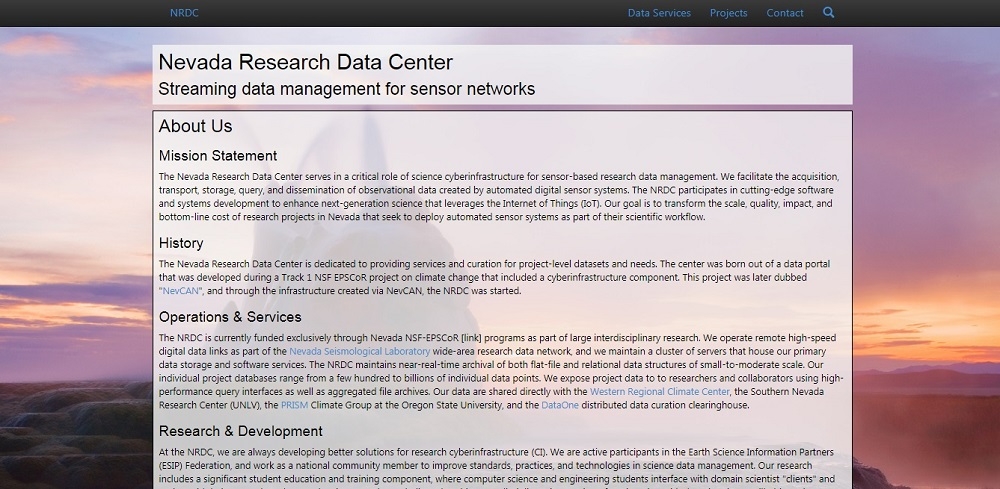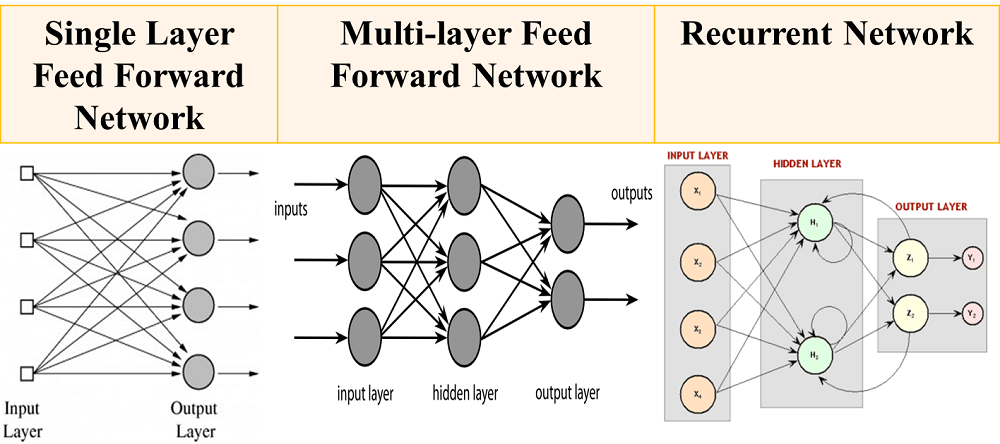Cyberinfrastructure—Shutterstock.com
Weaving a Web of Support
NEXUS Cyberinfrastructure creates the foundation for gathering, processing, sharing and applying scientific data
By Jane Palmer
October 2018
The Nevada Research Data Center
NRDC: http://www.sensor.nevada.edu/NRDC/
Supporting Science Discovery: The Nevada Research Data Center—Sergiu Dascalu and Frederick C. Harris, Jr.
Connecting and Communicating
NEXUS Connectivity—Solar Nexus project
Types of Neural Networks Used for Prediction—Shahram Latifi
“The way the compression works is you guess what the data is going to be and then you send only the difference between the predicted and actual values,” Latifi says. “If you’re right on, the difference would be zero and you have nothing to send.” If the prediction doesn’t match the observations all that needs to be stored is the difference between the predicted and observed result, not the entire new recorded data set. Using such a technique no information is lost in the compression. For such “lossless compression” typically the amount of data transferred is only reduced by a factor of two or three. But using the neural network model, the team has been able to achieve compression factors of eight or nine. “These compression ratios are phenomenal and should be able to save us lots of storage space and communication bandwidth,” Latifi says.
Deductions From Data
As well as facilitating the transmission data for NEXUS scientists who are aiming to maximize solar energy efficiency or minimize its impacts on the environment, NEXUS CI researchers also use and process the data to solve scientific challenges in renewable energy.
For example, NEXUS researcher Dr. Lei Yang, at UNR, has used a combination of big data analytics and statistical models to provide more accurate and therefore valuable estimates of wind power. Wind is a highly variable and intermittent source of energy, which means that integrating it into the power system can prove tricky. Power companies engage in a delicate balancing act, day in and day out, to balance energy demand and energy supply.
To deploy this juggling act efficiently requires accurate forecasts of when the wind levels will rise and fall. But, at present, current wind forecasts are highly inaccurate. Yang’s goal is to provide more accurate and therefore valuable estimates of wind power. “We cannot control wind, but we can forecast wind,” Yang says. “So if we can do a good job in the forecasting then pretty much we can achieve our mission of pure, clean energy in the end.”
Big Data Analytics and Statistical Models—Lei Yang
NEXUS scientists Jiao Cheng, Mei Yang, Jacimaria Batista, and Yingtao Jiang from UNLV collaborating with Zhao Fu from the Nevada Water Authority have also developed a model to predict industrial wastewater quality. NEXUS scientists Connor Scully-Allison, Hannah Munoz, Scotty Strachan, Eric Fritzinger, and Vinh Le, all from UNR have developed software applications to advance modern data management practices. And, in addition to providing a foundation for the NEXUS project, CI researchers Fred Harris, Lei Yang, and Mehmet Gunes from UNR and Latifi and Juyeon Jo from UNLV have increased Nevada’s cyber capabilities for interdisciplinary research and education by developing advanced tools for data visualization, mining, and security.
Data Visualization of Fire Simulation in Kyle Canyon—Solar Nexus project
“Our CI project is important because it develops capacities that we didn’t have in the past in Nevada,” Dascalu says. He also notes that without the NRDC, the key CI component of the NEXUS project, earth science-related research taking place in Nevada would continue to be highly localized and relying on non-standardized bespoke solutions to commonly occurring data problems. “This traditional approach to data management without CI would stifle scientific progress by limiting the dissemination of critical data needed to reproduce research and perform new analyses,” Dascalu says.
NRDC Development and Operation: Eric Fritzinger, Alexandra Younkes, Hannah Munoz, Connor Scully-Allison, and Vinh Le—Alexandra Younkes Photo
Creating the Human Infrastructure for Tomorrow’s Cyberinfrastructures
While the NEXUS cyberinfrastructure (CI) provides a framework for supporting science discovery, at its heart it is powered by skilled experts trained in computer science and engineering. Consequently, to keep the infrastructure healthy, the NEXUS CI team has provided many training opportunities for graduate students and undergraduates. By November 2018, eight NEXUS-funded students will have attained their PhDs, ten NEXUS-funded students will have attained their Masters, and more than ten undergraduate students will have worked on the NEXUS project in a CI role.
The students have been involved in every aspect of the CI development including building applications for use by NEXUS scientists and engineers. For her Masters project University of Nevada Reno (UNR) student Hannah Munoz has developed a software analysis tool to estimate cloud and snow cover. A webcam takes image streams at various locations and a user can use the tool to select different sections of time to analyze and retrieve the snow and cloud cover estimates over that time period. Such estimates can verify and validate measurements taken by other sensors in the network and this type of project has contributed to enhancing the software available to environmental scientists seeking to quantify results from webcams in sensor networks, says NEXUS scientist Dr. Sergiu Dascalu at UNR.
“People are at the core of all NEXUS research and development work,” Dascalu says. “The NEXUS project has substantially contributed to Nevada’s workforce development by preparing professionals with unique, advanced skillsets and experience in interdisciplinary work.”
_______________________________________

NEXUS Notes is a monthly publication of the Solar Nexus Project, which is a five-year research project funded by the National Science Foundation’s Established Program to Stimulate Competitive Research “EPSCoR” (Cooperative Agreement #IIA-1301726) focusing on the nexus of (or linkage between) solar energy generation and Nevada’s limited water resources and fragile environment.
Any opinions, findings, and conclusions or recommendations expressed in this material are those of the author(s) and do not necessarily reflect the views of the National Science Foundation.
_______________________________________
If you would like to know more about the NEXUS project,
please contact, Dr. Gayle Dana
Gayle.Dana@dri.edu
530-414-3170
_______________________________________













